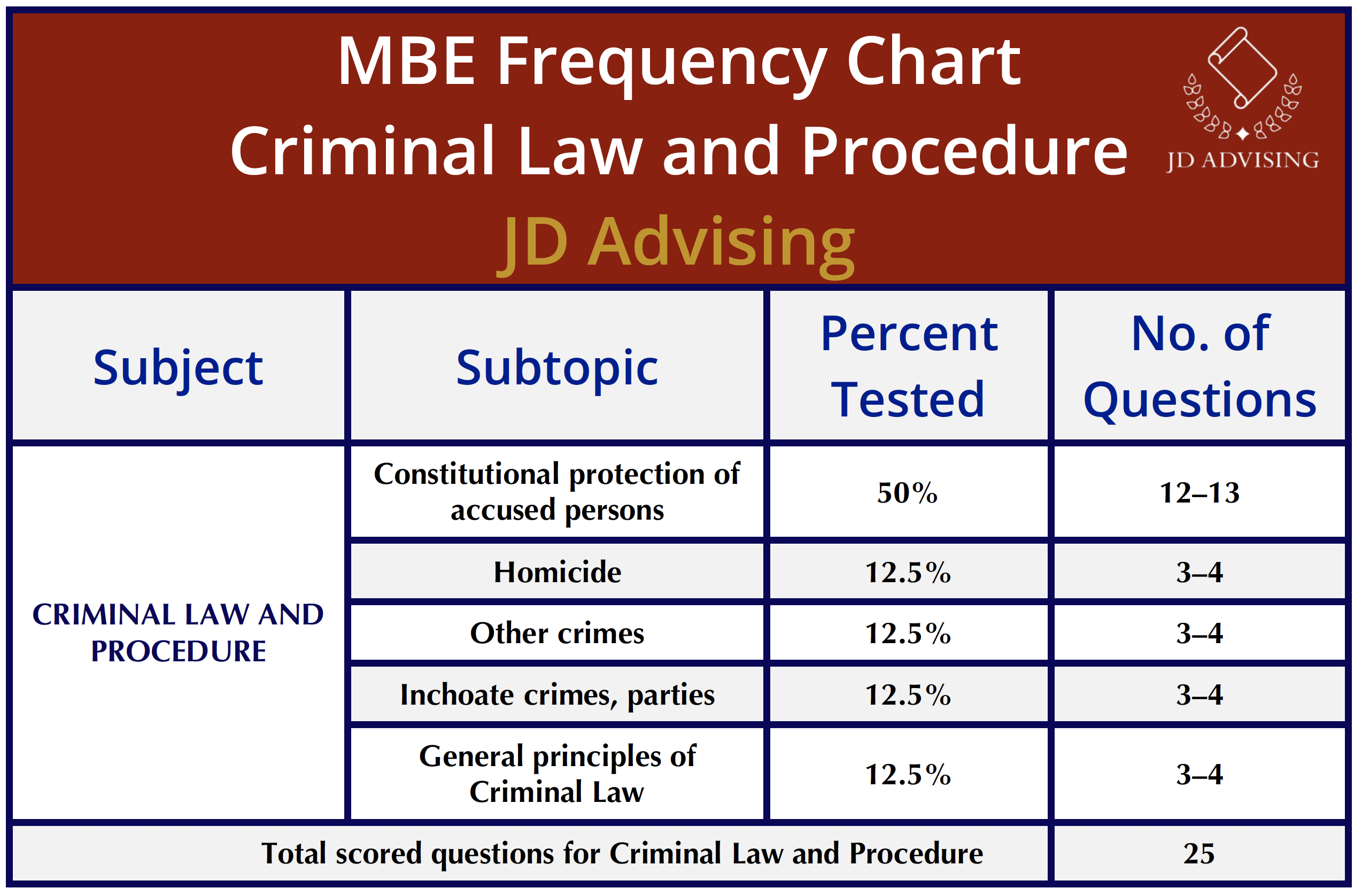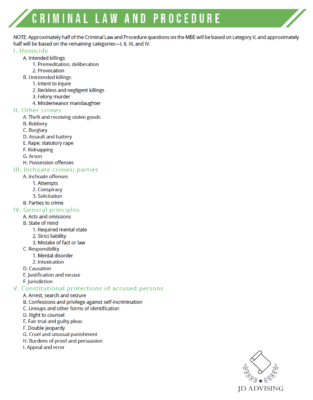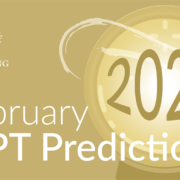Topic 8: Criminal Law and Procedure on the MBE: Key Topics
Please see our new, most updated, free MBE Guide here!
Criminal Law and Procedure on the MBE: Key Topics to Know
Here, we cover Criminal Law and Procedure on the MBE! Out of the 175 scored multiple-choice questions, you can expect to see 25 Criminal Law and Procedure questions. The NCBE breaks down the subject into five categories of topics, some emphasized more than others. Overall, you can expect to see about half of the questions test Criminal Law while half will test Criminal Procedure.
Criminal Law and Procedure on the MBE: Breakdown by Topic
The NCBE breaks down Criminal Law and Procedure into five categories: general principles of criminal law, homicide, other crimes, inchoate crimes and parties, and constitutional protections of accused persons. You can see that the first category (constitutional protections of accused persons, or Criminal Procedure) makes up half of the questions. The other half of the MBE questions will be composed of Criminal Law questions. Homicide also is a particularly important topic as there are 3–4 questions on homicide and it appears on many essay exams, including the Multistate Essay Exam and state bar exams such as the California Bar Exam. 
Criminal Law and Procedure on the MBE: NCBE Subject Matter Outline
This Criminal Law and Procedure subject matter outline is promulgated by the NCBE (and re-styled by JD Advising). You can see the five primary Criminal Law and Procedure categories that are tested as well as the topics tested within those categories. The NCBE subject matter outline is available for download here if you prefer to see it in PDF form. Any of the issues listed in the NCBE’s outline are ripe for testing in Criminal Law and Procedure questions.
Criminal Law and Procedure on the MBE: Key Topics to Know
Key topics in Criminal Law and Procedure on the MBE include the following:
General principles of Criminal Law
You will see about 3–4 general principles questions in Criminal Law and Procedure on the MBE. Know that the prosecution must prove every element of a crime beyond a reasonable doubt. So, if an answer choice asks you to switch the burden of proof of an element of a crime to the defendant, it is wrong. However, the court may require that a defendant prove an affirmative defense. While each individual crime generally has its own specific elements, every crime (for the most part) requires proof of four general elements: an act, mens rea (mental state), causation, and concurrence. If one of these is absent, there can be no conviction.
One of the most important concepts to memorize is the difference between the various mental states.
- Specific intent crimes require the defendant to have had the conscious object or purpose to achieve a specific result. These crimes include theft crimes, inchoate crimes, assault, and first-degree murder. If the defendant did not have the intent to commit the specific charged crime, he or she will not be guilty no matter if they were unreasonable, drunk, or had some other silly reason for not being able to form the specific intent.
- On the contrary, malice crimes require recklessness or intentional disregard of an obvious or known risk that a result will occur. These crimes include second-degree murder and arson.
- General intent crimes require proof that the defendant intended to do an act even if he or she did not intend the specific result. These crimes include battery, rape, false imprisonment, and kidnapping.
If you can identify the defendant’s mental state, you can narrow down the crimes that he could be liable for!
Homicide
You will see about 3–4 homicide questions in Criminal Law and Procedure on the MBE. Oftentimes these questions will ask what level of homicide a defendant can be convicted of. So, understanding the various levels of homicide is critical to reaching the correct answer! It helps to break down this topic into intentional vs. unintentional killings. We have a description and a convenient chart below.
- First-degree murder is an intentional killing done with premeditation and deliberation.
- Voluntary manslaughter is an intentional killing done in the heat of passion due to adequate provocation.
- In contrast, second-degree murder is (typically) an unintentional killing. The mental state here is extreme recklessness or intent to do great bodily harm. There also is a third category of second-degree murder that is classified as an intentional killing that does not meet the requirements of first-degree murder or voluntary manslaughter (we call it the “catch all” category).
- Involuntary manslaughter is an unintentional killing due to recklessness or gross negligence.
- Finally, felony murder is an unintentional killing that occurs during the commission of a felony. The required mental state here is an intent to commit the underlying felony.
This category is further proof that memorizing mental states and identifying the voluntariness of crimes is a great way to pick up points!
Other crimes
You will see about 3–4 questions on other crimes in Criminal Law and Procedure on the MBE. The following crimes are listed by the NCBE as fair game for the MBE: theft and receiving stolen goods, robbery, burglary, assault and battery, rape and statutory rape, kidnapping, arson, and possession offenses.
The key here is simple: memorize the elements! For example, common law arson is (1) the malicious (2) burning (3) of the dwelling (4) of another. If one of these elements is missing, then the defendant cannot be convicted of arson! Some of the names of crimes might be colloquially used interchangeably, like larceny, robbery, and burglary. However, each has its own distinct set of elements. If you can memorize the elements for each crime, you will stand a good chance of being able to identify the correct one on the MBE!
Inchoate crimes and parties
You will see about 3–4 inchoate crimes and parties questions in Criminal Law and Procedure on the MBE. “Inchoate” is a fancy word for “incomplete.” So, an inchoate crime is an incomplete crime. Inchoate crimes include attempt, solicitation, and conspiracy. When you are confronted with one of these crimes on the MBE, the question might ask you what the defendant can be charged with.
Thus, it will be important to remember the doctrine of merger. For attempt and solicitation, if the crime ends up actually being completed, then attempt and solicitation will merge with the completed crime. This means that one cannot be charged with both, say, attempted burglary and burglary, or solicitation of burglary and burglary. However, this is not the case with conspiracy. The law especially does not like when two people agree to commit a crime! So merger will not occur here. Therefore, one can be charged with both conspiracy to commit burglary and burglary.
Remember: Accomplice liability is not a crime! It is a way for a person to be found liable for a crime.
When considering parties to a crime, you might see a situation that involves both a principal and an accomplice. A principal is a person who commits the crime. An accomplice is a person who assists or encourages the principal with the intent that the crime be committed. Remember that for accomplice liability, mere words are enough for an accomplice to be found liable. If one meets the requirements to be an accomplice, they can be liable for all crimes committed that they aided or encouraged as well as all natural and probable results of the crimes. One common mistake we see examinees make is that they think accomplice liability is a crime in and of itself. The NCBE might include an answer choice that suggests someone be charged with accomplice liability in order to trick you. Don’t fall for this trap! Accomplice liability is just a vehicle we use to hold one accountable for the crimes they helped another commit.
Constitutional protections of accused persons
You will see about 12–13 constitutional protections of accused persons questions in Criminal Law and Procedure on the MBE. This category encompasses the entirety of Criminal Procedure, and unfortunately, the NCBE itself does not break it down any further in terms of frequency for testing. However, there are two main sub-categories here: search and seizure, and interrogations and confessions. Search and seizure encompasses Fourth Amendment principles while interrogations and confessions involve the Fifth, Sixth, and Fourteenth Amendments.
One key distinction that trips a lot of examinees up in the search and seizure sub-category is the two warrant exceptions that involve vehicle searches.
- Officers can use the search incident to arrest exception to search an unsecured arrestee’s wingspan in a vehicle, or to search a secured arrestee’s vehicle if it is reasonable to believe evidence relating to the applicable crime will be found in the car. They cannot search the trunk. They can only search the “wingspan” (i.e., where the arrestee could reach—someone typically cannot reach into their trunk from the front seat!).
- An officer can use the automobile exception to search a vehicle if there is probable cause to believe evidence or contraband is present in the vehicle. However, make sure to consider what the officers have probable cause to search for. If they are looking for a gun, they wouldn’t have probable cause to search inside something small like a cigarette box.
Another distinction the NCBE likes to test is that between the Fifth and Sixth Amendment right to counsel. Under the Fifth Amendment, anyone subject to a custodial interrogation by a government agent has the right to counsel. They must be informed of this right through the administration of Miranda warnings. On the other hand, the Sixth Amendment right to counsel attaches only after a defendant has been formally charged with a crime. Thereafter, the defendant will have the right to counsel at all critical stages of the proceedings. So, when you are considering answer choices that present the Fifth and Sixth Amendments, pay close attention to where we’re at in the legal proceedings! This will make all the difference!
Go to the next topic, Topic 9: Evidence on the MBE: Key Topics.
Seeking MBE Assistance?
Seeking MBE Assistance?
- 📘 MBE Guide: Equip yourself with our FREE expert-crafted bar exam and MBE guides.
- Free Bar Exam Resource Center: Discover top resources, articles, and free webinars led by renowned bar exam professionals.
Top Resources as Vouched by our Students:
- MBE One-Sheets: One of our most highly acclaimed bar exam supplements!
- Bar Exam Outlines: Our comprehensive and condensed bar exam outlines present key information in an organized, easy-to-digest layout.
- MBE Private Tutoring: Opt for personalized, effective strategies.
- On Demand Bar Exam Course: Comprehensive bar exam preparation.
- Bar Exam Crash Course and Mini Outlines: Acclaimed and effective for a quick refresher.
- MBE Mastery Class, Real MBE Questions, and MBE Guide: Elevate your MBE preparation with these high-quality MBE supplements!
🔥 NEW! Check out our Repeat Taker Bar Exam Course and get introduced to our unmatched platinum Guarantee Pass Program.








Hi Helen, our MBE QBank has 1,657 questions and we are adding more on a regular basis. All of the answers include complete explanations for all correct and incorrect answers. Regarding your access, we remove access after each administration. So, on August 1 (for July takers) and March 1 (for February takers) we remove access to the QBank and data from the QBank. These dates will be extended for fall bar exam takers due to COVID-19. If you have other questions, feel free to email us at info@jdadvising.com.
How long can I access the material?
Does answers include complete explanations?
How many questions?